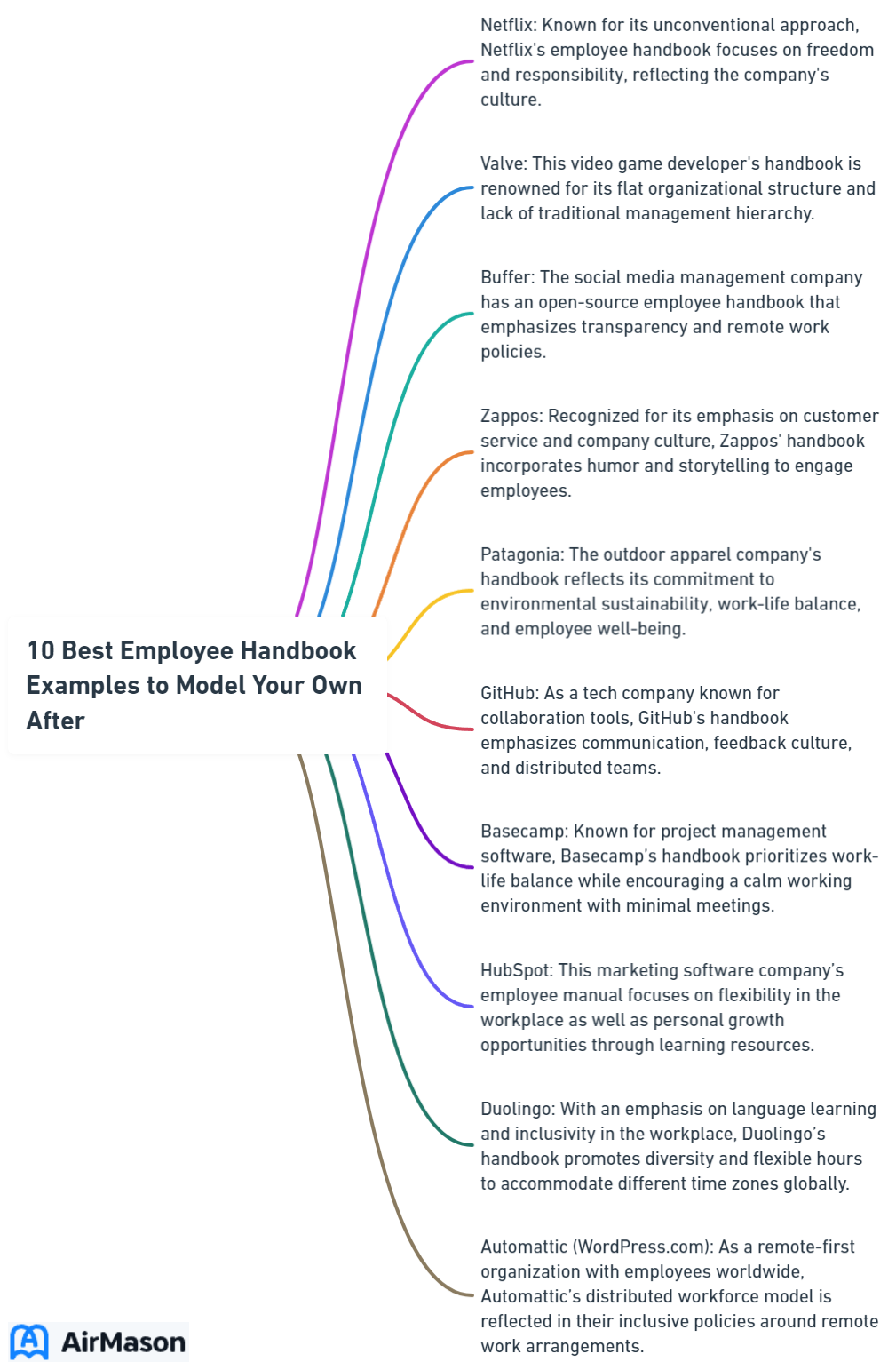
Crafting an employee handbook? Draw inspiration from the best. This article provides a curated list of ten employee handbook examples from successful companies. Discover how industry giants and up-and-coming players alike approach this crucial document. Understand how they encapsulate culture, policies, and employee expectations into a handbook that speaks to their workforce. These examples will serve as a guide, helping you to create or refine your own handbook with best practices in mind.
Key Takeaways
- Employee handbooks are vital for communicating company policies, expectations, and culture, and provide legal protection by informing employees of rules and consequences for non-compliance.
- Creating an effective employee handbook should involve understanding the audience, organizing information logically, incorporating employee feedback, ensuring multimedia accessibility, and regularly updating the content.
- Successful companies like Netflix, Zappos, Valve, Google, Nordstrom, HubSpot, Trello, and Airbnb use their handbooks to reflect unique cultures and values, ranging from transparency and well-being to simplicity and inclusivity, even leveraging their own tools for interactive engagement.
The Importance of Employee Handbooks

An employee handbook, also known as an employee manual, is an essential tool for businesses, providing a clear understanding of company policies, performance expectations, and employee behavior guidelines. It serves as a compass for both new employees and existing employees, guiding them through the corporate landscape and helping to foster a unified company culture. New employees employee handbooks are crucial in maintaining consistency and clarity within the organization, and creating your own employee handbook can ensure it aligns with your specific needs.
Beyond clear communication, the employee handbook also provides legal protection for the company. It serves as a safeguard, reducing legal liability by proving that it is used to inform employees of rules and the consequences of non-compliance. This is particularly important for issues such as workplace harassment, safety procedures, and the use of company property.
Moreover, the employee handbook can serve as a valuable resource when questions arise. This is particularly useful in conflict resolution scenarios, providing a framework for fair and consistent treatment. A professional and error-free employee handbook conveys dedication to employees, reinforcing their understanding of the company’s values and policies.
Crafting a Unique and Effective Employee Handbook
Creating an effective employee handbook requires:
- Consideration of the audience
- Logical organization
- Multimedia accessibility
- Incorporation of employee insights
- Regular updates
It’s a balancing act, but by following these guidelines, you can create a handbook that is informative and engaging for your employees.
One crucial element is catering to the background, role, and departmental requirements of the audience. By considering these factors, you can enhance understanding and investment in the company’s values and policies. Additionally, organizing the handbook into logical sections ensures that employees can conveniently reference policies and resources.
Another important aspect is gathering employee insights on the handbook’s content. This fosters an environment of continuous learning and adaptation, making the handbook a living document that evolves with the company. Regular updates ensure that the handbook remains a trusted source of company guidelines, reflecting the latest legal and procedural information.

Netflix: Culture Deck
Netflix’s Culture Deck is a prime example of how a company’s culture can be effectively communicated via an employee handbook. The Culture Deck emphasizes an empowerment-centric ethos, encouraging employees to make decisions and contribute to the company’s success.
One of the unique aspects of Netflix’s culture is its dream team concept, which is paired with performance-focused management tools. The company believes in retaining only highly effective personnel, ensuring that the team’s success is a priority. To support this, employees are paid at the top of their personal market, fostering an environment of trust and responsibility.
The Netflix Culture Deck, presented in a direct 129-slide format, sets a tone of trust and accountability, which has become central to Netflix’s success. The deck instills core values such as candid communication, innovation, and continuous improvement, underlining the company’s firm stance on ethical behaviors and high performance.
Employee Handbook Design
Employee handbook design plays a crucial role in conveying organizational values, policies, and expectations effectively to employees. A well-crafted handbook design not only ensures clarity but also enhances employee engagement and adherence to company policies. When considering employee handbook design, it’s essential to incorporate elements that reflect the company’s branding and culture while maintaining readability and accessibility. Visual elements such as infographics, icons, and color schemes can help break down complex information and make the handbook more engaging. Additionally, using a clear and concise writing style with relevant examples can aid in better comprehension and retention of the handbook content by employees. Regular updates and revisions to the design ensure that the handbook remains current and aligned with any changes in company policies or regulations.
Zappos: Culture Book

Zappos stands out with its unique Culture Book, a testament to their commitment to a cohesive workplace culture. The company believes that culture is instrumental to both success and failure, and the Culture Book serves as a reflection of this belief.
The Culture Book is more than just a list of policies; it’s a vibrant tapestry of stories, photos of staff, and real testimonials, designed with a unique comic book theme. This contributes to showcasing the company’s culture, company values, and company’s mission, strengthening the sense of ownership and community among employees.
Zappos’ initiative to share its distinctive company culture globally through Zappos Insights is exemplified by the Culture Book. This approach has cemented Zappos as a leader in cultivating a unique and effective company culture.
Valve: A Playful Approach

Valve, a video game developer, presents a playful and unique approach to their employee handbook. The handbook fosters creativity, personal initiative, and a work environment that balances work and leisure.
Valve’s ‘Flatland’ structure is detailed in the handbook, encouraging employees to choose their projects and act without waiting for permission. This level of autonomy fosters an environment of innovation and creativity.
The handbook itself is presented in a fun storybook format, using an easygoing and humorous tone. This approach not only makes the handbook engaging to read but also embodies the company’s informal and creative ‘Flatland’ structure.
Google: Embracing Transparency and Well-being
Google’s employee handbook is a testament to the company’s commitment to transparency and well-being. The company shares information extensively with its employees, fostering a transparent work environment.
Transparency at Google includes:
- Addressing important company issues and cultural challenges openly
- Decision-making processes that aim for objectivity, free from biases
- Encouraging employees to set their own targets, which align with the company’s broader objectives
- Management roles that focus on understanding individual contributions rather than directing staff.
Google advocates for the mastery of skills among its employees by:
- Having top performers lead training sessions
- Embracing failure to foster innovation and continuous learning
- Offering dynamic compensation for exceptional skills
This approach creates a culture of continuous improvement and growth.
Nordstrom: The Power of Simplicity

Nordstrom’s employee handbook is a shining example of the power of simplicity. The handbook distills its guidance into a singular rule that espouses the use of good judgment and captures the company’s dedication to customer service and empowerment of staff. Such handbook examples demonstrate the effectiveness of concise and clear guidelines for employees.
Historically, Nordstrom’s employee handbook was presented on a single 5×8” card, symbolizing the company’s streamlined approach to guiding principles. This approach builds a culture of trust, suggesting that employees are capable professionals expected to continuously strive for excellence and to confidently engage with challenges under the company’s supportive management.
Good judgment, customer-centric culture, teamwork, respect, and professionalism are the cornerstone principles that define Nordstrom’s employee handbook and corporate ethos. This simple yet effective approach sets Nordstrom apart in the realm of employee handbooks.
Employee Handbook PDF
An employee handbook PDF serves as a comprehensive guide outlining company policies, procedures, and expectations for employees. When creating or updating an employee handbook PDF, it’s crucial to ensure clarity and accessibility, as this document serves as a reference point for both employers and employees. Including topics such as company culture, code of conduct, benefits, and disciplinary procedures can help streamline communication and set clear expectations. Furthermore, providing a PDF format ensures easy distribution and accessibility across different devices and platforms. Regular updates to the employee handbook PDF are essential to reflect any changes in company policies or regulations, keeping all stakeholders informed and aligned.
HubSpot: Culture Code
HubSpot’s Culture Code is a powerful reflection of the company’s dedication to creating a positive and inclusive work environment. Originally an internal document, the Culture Code is now publicly available, showcasing their commitment to transparency within and outside the company.
The Culture Code emphasizes:
- Autonomy, with a flexible approach that values results over where or when they are achieved, including a relaxed dress code
- A flat organizational structure that encourages employees to influence beyond their titles
- Promoting autonomy throughout the company
The Culture Code guides employees on their goals without micromanaging the journey, reinforcing the virtue of empowerment. With its HEART values—Humble, Empathetic, Adaptable, Remarkable, Transparent—mirroring the Culture Code’s drive for a supportive and developmental workspace, HubSpot has created a powerful tool for fostering a positive company culture.
Trello: Using Their Own Product
Trello has taken an innovative approach to their employee handbook by using their own product, a web-based project management app, to present it. This creative use of their own tool not only showcases its versatility and utility but also reinforces its usability and embeddedness in the company’s culture.
The employee handbook boasts features like:
- Real-time updates for current information
- A collaborative platform for employee engagement
- Enhancements such as the Employee Handbook Power-up that enhance guide creation and management, including employee benefits information
- A customizable web portal
By using their own product for the employee handbook, Trello demonstrates that an employee handbook can be more than just a physical document. It can be an interactive, engaging tool that reflects the company’s culture and values.
Airbnb: Remote Policy and Inclusivity
Airbnb’s Remote Policy is a standout feature of their employee handbook. The policy encompasses a company culture that values meaningful human connections, aligning with the core values of embracing individual uniqueness and fostering belonging.
The policy allows employees the freedom to work in a manner that suits their personal productivity, including the option to work from home or any location in the country of employment. Coordination among remote employees is facilitated through adherence to specific time zones, promoting a unified company schedule.
Airbnb not only allows flexibility in work location but also actively recruits from a diverse set of communities and provides guidance on creating inclusive virtual meetings. This focus on inclusivity ensures every employee, irrespective of their location, has an equal opportunity to contribute.
Summary
This exploration of standout employee handbooks provides insights into how companies can effectively communicate their culture and values. From Netflix’s Culture Deck emphasizing honesty and high performance to Nordstrom’s simple yet effective approach emphasizing good judgment, these examples showcase the potential of a well-crafted employee handbook.
Each company has a unique approach to their handbook, reflecting their unique culture and values. Whether it’s Zappos’ unique Culture Book fostering a sense of community or Trello using its own product to present its handbook, these examples demonstrate the power of creativity in crafting an effective handbook.
In conclusion, an employee handbook is more than just a list of rules and regulations. It’s a tool that, when used effectively, can foster a positive work culture, engage employees, and contribute to a company’s success. So, are you ready to create your own standout employee handbook?
Frequently Asked Questions
What an employee handbook should contain?
An employee handbook should contain policies on standards compliance, employee classification, pay frequency, performance evaluations, bonuses, HR forms, company programs, procedural guidelines, mission statement, equal employment opportunity statement, company background, business policies, employee expectations, legal obligations, and employee rights. It should cover a wide range of topics to effectively communicate with employees.
How do you write a good employee handbook?
When writing a good employee handbook, be sure to include a welcoming introduction, key workplace commitments, company policies and procedures, employment classification, attendance and leave policies, work performance, and a discipline policy. Additionally, gather feedback and reflect company values in your policies to ensure an effective handbook.
What should be avoided in an employee handbook?
Avoid including topics like permanent position, due process, probations, and ignoring legally required policies like FMLA or federal, state, and local laws. Also, make sure to include information on leaving the company and how resignations, terminations, and retirements will be handled.
What is a better name for an employee handbook?
Consider renaming the employee handbook to Employee Guide, Employee Manual, or Employee Playbook to make it more accessible and engaging for employees. A new name can provide a fresh perspective and highlight the importance of the document.
Why are employee handbooks important?
Employee handbooks are important as they provide clarity on company policies and legal protection, serving as a valuable resource for both employees and the company.
Disclaimer:
Please be aware that the content on this page has been generated by using artificial intelligence language models and may contain errors, inconsistencies, or outdated information.
It is provided as-is without any warranties or guarantees of accuracy. We strongly recommend using this content as a starting point for further research. We disclaim any liability for damages or losses resulting from the use or reliance on this content.